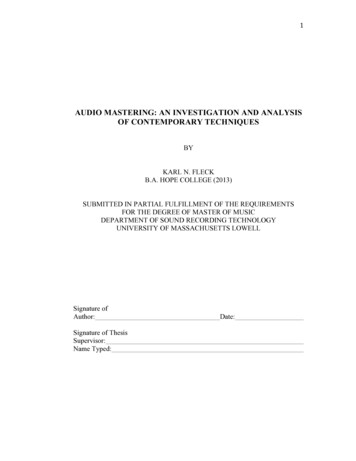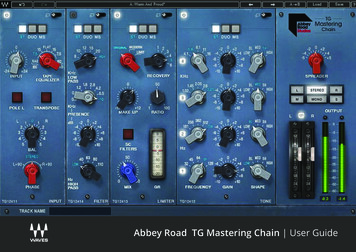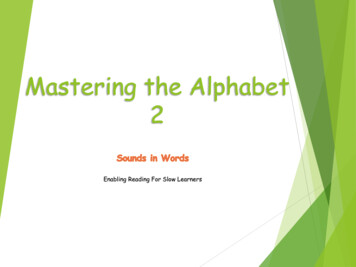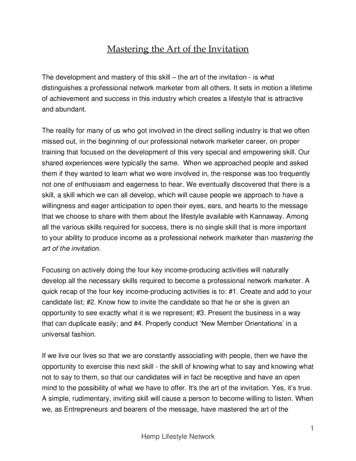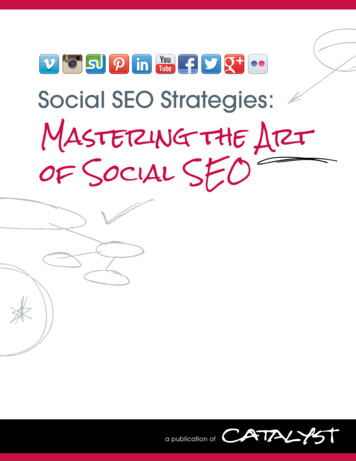
Transcription
Social SEO Strategies:Mastering the Artof Social SEOa publication of
ForewordOver the past decade, social mediahas evolved considerably. Fromits emergence with Friendster andMySpace, to its massive explosionwith Facebook, Twitter, and countlessother networks, social media is nowa part of everyday life for people allaround the world today.Not surprisingly, the search engineswant to capitalize on the socialsignals produced when usersparticipate in social networks.The challenge for today’s searchengine marketer is to learn how tooptimize for those signals, and tointegrate them into a SEO program.This eBook is designed to providesearch marketers with theframework needed to build andexecute an efficient and effectivesocial SEO campaign.2We hope you find this social SEOeBook of value — please let usknow what you think. And be sureto share it with your personal andprofessional networks.We would also like to thank our teamof authors for their vast knowledge,innovative thinking, and unwaveringdedication to this project. For moredigital marketing insights from ourauthors, please visit the Catalystblog.Mastering the Art of Social SEO 2013, Catalyst Online LLC.Share This
Contributing AuthorsAndrea Caruso - Organic Search ManagerGarth O’Brien - Organic Search DirectorAndrea Caruso is an OrganicSearch Specialist for Catalyst.She has over eight years ofmarketing experience, andholds a master’s degree inInternet Marketing from FullSail University. She has doneorganic search optimizationfor a variety of industries,including higher educationand CPG, but also enjoys blogging, online communities,and social media. She is originally from Orlando, Florida,but currently resides in Boston, with her husband, daughter,and cat.Garth O’Brien is an OrganicSearch Director for Catalyst.With a decade of experience,Garth manages all aspects ofsearch engine optimization(SEO), social media, andonline marketing and onlinemarketing for various B2Band B2C clients. In addition,he has experience in paidsearch, and extensive community management includingengagement, recruitment, retention, and operations.Jason Corrigan - Organic Search ManagerClayburn Griffin - Organic Search DirectorJason Corrigan is an OrganicSearch Manager for Catalyst.He works with Fortune 1000companies, overseeing theplanning and executionof custom SEO and socialstrategies for various brands.Jason got his start in SEOthrough sales, selling localdirectories and socialmedia packages throughout the Albany capital district.In addition, he has worked in content marketing anddistribution with hundreds of businesses across the US andCanada.Clayburn Griffin is an OrganicSearch Director at Catalyst.He is an Internet marketingguy with an entrepreneurialmind who enjoys coming upwith ways to use technologyeffectively for business. Hisbackground in the crossroadsof social media and SEOhas helped him to providecomprehensive digital strategies to Catalyst’s clients.Previously he was a Social Marketing Director working onbrands such as Sony Music and HarperCollins.Dan Cristo - Director of SEO InnovationMatthew Proctor - Organic Search ManagerDan Cristo is the Director ofSEO Innovation for Catalyst.He is responsible for keepinga pulse on industry trendsand ensuring Catalyst isprepared for the future. He isa New-Jersey-based industryveteran with over 10 yearsof experience leading SEOstrategies for some of theworld’s largest brands. A fullfledged geek, Dan takes programming, chess, and tabletennis very seriously.Matthew Proctor got hisstart in Internet marketing byopening a freelance copywriting and SEO consultingpractice in 2007. As anOrganic Search Managerfor Catalyst, he createsSEO strategies and providescontent marketing, socialmedia, link building, andoverall search marketing recommendations for Fortune1000 brands. He is a member of the editorial team andregularly contributes to the blog.3Mastering the Art of Social SEO 2013, Catalyst Online LLC.Share This
Table of ContentsPart I: Understanding Social SEO . . . . . . . . . . . . . . . . . . . . 5Introduction . . . . . . . . . . . . . . . . . . . . . . . . . . . . . . . . . . . . . . 5Chapter 1: What Is Social SEO? . . . . . . . . . . . . . . . . . . . . . . 6Chapter 2: How Social SEO Works . . . . . . . . . . . . . . . . . . . . 7Chapter 3: Why Social SEO Matters . . . . . . . . . . . . . . . . . . 8Chapter 4: Preparing for Your Social SEO Campaign . . . 9Part 2: Making Social SEO Happen . . . . . . . . . . . . . . . . . 10Chapter 5: Learn the Three Pillars of Social SEO . . . . . . . 11Chapter 6: Define Your Social SEO Strategy . . . . . . . . . . 17Chapter 7: Select Your Social SEOPerformance Metrics . . . . . . . . . . . . . . . . . . . . . . . . . . . . . 19Chapter 8: Build Your Social SEO Team . . . . . . . . . . . . . . 21Chapter 9: Set-up Your Social SEO Campaign . . . . . . . . 23Part 3: Tactics and Tools . . . . . . . . . . . . . . . . . . . . . . . . . . 25Chapter 10: Social Network Tactics . . . . . . . . . . . . . . . . . 26Chapter 11: Social Network Tools and Automation . . . . 33About Catalyst . . . . . . . . . . . . . . . . . . . . . . . . . . . . . . . . . . 364Mastering the Art of Social SEO 2013, Catalyst Online LLC.Share This
Part I:Understanding Social SEOIntroductionIn July of 2011, Google launched. Soon the social platform was hailed as the first legitimate threat to Facebook. More than a year later, Facebook is still going strong, and Google’s new social platform continues todevelop. Today it boasts over 400MM users. And while its steady growth is impressive, Google is significant foran entirely different reason.Google represents a key turning point for the search industry. The platform brought more personalization toweb search than ever before. In doing so, it signaled a fundamental shift in how search engines present results— one where your search results are determined as much by the people you know, as by the sites that have themost links. In essence, Google created social search. Now all the major search engines strive for personalization and rely on social signals to improve their results.But this book isn’t about Google . It’s about how the desire to provide better/more personalized search results— combined with the social dynamics of the web, and the avalanche of content generated online — haveushered in a new era in search: social search engine optimization (social SEO). This book is intended to helpmarketers respond to this change by explaining how social SEO works, the implications it holds, and the tacticsneeded to capitalize on it.5Mastering the Art of Social SEO 2013, Catalyst Online LLC.Share This
Chapter 1:What Is Social SEO?Social SEO is the application of social signals to the search engine results. But what does that mean? What, exactly, is a social signal? And how does it impact the search results?Social signals are produced by individuals’ online activity. Each time you share some content, 1 an article,Like an image on Facebook, etc., it creates a social signal. The search engines use these signals to help themdetermine the quality/depth of an online relationship between individuals.But how do social signals actually impactthe search results?Understanding the quality of an online relationshipbetween individuals helps the search engines deliverbetter/more personalized results. Based upon theirassessment of an online relationship, the search enginesthen determine if a particular piece of content would bemore relevant to an individual. If so, they give it priority inthe search results.Let’s take a look at a simple example to illustrate:Widgets R Us (WRU), sells widgets. The WRU website isa leading authority on widgets and is already rankingwell. They have social profiles on Facebook, Twitter,and Google . Their connections on these social profiles(fans, Likes, circles, etc.) include other trusted companiesdealing in widgets, industry experts on widgets, brandadvocates, and widget fans.The company grows, and in addition to their existingwidgets, they release a brand new red widget. They postcontent about the new and improved red widgets ontheir website, and want it to rank well in the search results.So what do they do? They push links to social profiles toleverage their connections and expand the reach of theircontent.Since WRU is selling widgets, and is already a leadingauthority, their push to social profiles builds a cascade ofonline commentary from other reputable folks connectedto the widget industry. All that activity sends a signal to thesearch engines. It basically says to them, “Hey, you maywant to check-out all this new widget-buzz, and considerindexing and ranking it in the search results, particularly forpeople who are logged into Google and are connectedto these brands, experts, fans, and/or advocates viaGoogle , Facebook, or Twitter.”That, in a nutshell, is a social signal. And social SEO is aboutoptimizing for those social signals.Social SignalWidget experts. Widget fans& WRU advocatesWRU GOOGLE WRU TWITTERWRU FACEBOOK6Mastering the Art of Social SEO 2013, Catalyst Online LLC.Widgets R UsWebsiteShare This
Chapter 2:How Social SEO WorksTrust matters. Think about how it affects your everyday life. It influences the decisions you make for everythingfrom a serious health issue to choosing a movie. And the trust dynamic that exists between two people can beforged over decades or over coffee. But the degree of trust you have in an individual is often determined by thecloseness of the relationship. In other words, intimacy is a strong indicator of trust.Well, that is exactly the concept behind social SEO.In fact, it was discussed in Google’s “Social Search”patent submitted a year before Google was released.The patent reveals that search engines can use therelationship connections in a social network to betteranswer searchers’ queries, and that trust can bemeasured by intimacy.This approach is very different from the earlier searchmodel of using authority as a measure of trust. In adocument-based world (such as the early days ofthe Internet when only web pages existed), trust wasmeasured by how credible a document was. Thecredibility was measured by how many citations (links)a web page received. This is why link building is suchan important aspect of SEO. Web pages need links toimprove their credibility or “trust” in the eyes of the searchengines. This, in turn, improves their rankings.But, as the patent states, in a social environment, youdon’t measure trust by authority; instead, you measure itby intimacy. For example, if a family member recommendsa good restaurant, you’re more likely to believe them thanan anonymous reviewer online. That’s because you knowyour family member, and because of that relationship/closeness, you have trust.Social search represents considerable opportunity forsearch engines because they want to deliver morepersonalized search results. But in order to do so, theyneed to understand who you know and how well youknow them. Tapping into your online social signals allowsthem to do just that.A quick experiment from one of our team members helpsto illustrate how search engines are trying to understandonline social relationships, how search is changing, andhow social SEO works:Shortly after Google was released in 2011, I receivedan invitation from a friend to try out the site. I set-updozens of circles, 1’d my favorite sites, and starteda hangout (group video chat) with some friends.The site and features were interesting, but I failed tounderstand its impact until I did a search.7I had a pharmaceutical client who makes a drug totreat stroke symptoms. To prepare for an upcomingpresentation, I did a search for “stroke treatment” andtook a screenshot of the search results.An article on stroke treatment written by a doctorappeared at the bottom of the first page. I hoveredover the small picture of the author’s face in the list,and noticed that I could add him to a Google circle.So, I created a new circle called “doctors” and 1’dthe article he wrote.Then I performed my search for “stroke treatment”again. This time, the doctor’s article was in the numberone position in my search results!So what happened? What caused the doctor’s listing tosuddenly sky-rocket to the top of the search results?Once the doctor was added to a circle, Googlefigured the individual knew him and trusted what herecommended. Based upon that assumption, they movedhis web page to the top of the person’s search results. Butthe increase in the doctor’s ranking wasn’t solely due tohim being added to a circle. His rise to the top spot wasalso due to the fact that:**The doctor was highly relevant to the individual’ssearch; after all, the doctor is an expert in stroketreatments.**The doctor is highly credible since he actually is aphysician, and his site has many other sites linking to it.As you can see from this experiment, social SEO leveragesthe trust that is passed along in online relationships viasocial signals.At its core, social SEO is about influencing the influencersto engage with your content, and optimizing for socialsignals. As the “well connected” in social environmentsinteract with your content online, they are, in a sense,recommending that content to their followers. And it isthat recommendation that can improve rankings at scale.Mastering the Art of Social SEO 2013, Catalyst Online LLC.Share This
Chapter 3:Why Social SEO MattersSo now that you know what social SEO is, and how it works, you need to understand why it matters today.Social SEO is important for marketers because search has evolved. Gone are the days where search resultsare determined solely by how many keywords are on a page, or how many links a site has. In fact, many SEOtactics that worked in the past will actually damage your search rankings today.Instead, the social signal — people talking about yourcontent on their social profiles — is becoming more andmore relevant to search. In fact, even Matt Cutts, thewebspam guru at Google, acknowledged that socialsignals are becoming important. Now search resultsare highly personalized to the searcher. They take intoaccount many data points including who you are, whereyou are, who you know, what you like, and where you’vebeen online. In other words, search truly has changed.Embracing social SEO is key because this trend of highlypersonalized search results is growing exponentiallyas the amount of data we share about ourselves andothers increases. For example, industry stats indicate thatYouTube members upload 72 hours of video content everyminute. In the same amount of time, Facebook membersshare 684,478 pieces of content. Then there is the contentgenerated on the wildly popular sites like Pinterest, Twitter,LinkedIn, Google , Tumblr, not to mention all the blogposts, emails, text messages, Word documents, photos,and billions of other pieces of content.Now search engines analyze all this content to betterunderstand searchers’ queries and the type of resultsthey prefer. Their desire to provide more personalizedsearch results — combined with the social dynamics of theweb and the deluge of online content being shared —underscores the importance of adopting social SEO.Clearly, social SEO is a game-changer as it can affectyour visibility and rankings in the search engines. Smartmarketers will adjust their strategies to accommodate thechange to ensure their brands achieve maximum visibility.8Mastering the Art of Social SEO 2013, Catalyst Online LLC.Share This
Chapter -4100Preparing for Your Social SEO CampaignNow that you know what social SEO is, how it works, and why it’s important, the next logical question is, “Howdo you prepare to optimize for it?”The answer is to take what we know of traditional SEO,and apply those principles to the social graph. Think ofit this way: if building authority was done by improvingthe quality and quantity of inbound links, then buildingintimacy is done by improving the quality and quantityof social connections.But how do you judge the quality of an online socialconnection? You do it the same way as you do in reallife. You measure it by how well you know someone, howdeeply you’ve interacted with them, and how much theirinterests align with yours.For example, if you meet someone in person for the firsttime, you may know their name, and you may be ableto tell whether you like to be around them or not, but youwouldn’t say that you trust them yet. And chances arethat you would probably rate the quality of that socialconnection as pretty low. In the same way, you mightknow the name of a company or brand, and you mightLike it on Facebook or 1 them on Google , but thatdoesn’t mean you necessarily trust them, or that youwould rate that social connection as high quality.In real life, a deep/quality relationship usually involvestwo people spending time together. They hang out, chat,call each other, ask for one another’s opinions, and shareexperiences, etc. Today, all of those things can be doneonline. When that happens, they produce the types ofsocial signals that search engines look for when assessinghow deep a relationship goes online.9To optimize for social SEO, you should start to engage withyour online connections on a deeper level. Doing so willsend important social signals to the search engines thatwill translate into earned trust, and help your content rankbetter in the search results.In addition to improving the quality of your onlinerelationships, you should also strive to gain anunderstanding of how each social interaction affectsrankings. Ideally, you want to be able to answer thefollowing questions:**What platforms and networks are most important?**How much of an impact will a single tweet, Like, orshare have on the rankings?**How do we get influential individuals to share ourcontent?**How do we measure the impact?Your ability to address these types of questions is key todeveloping a solid foundation for your social SEO programover the next few years. Ultimately, your answers will helpyou create a strategy that will determine whether futurealgorithm changes will help or hurt your rankings.Mastering the Art of Social SEO 2013, Catalyst Online LLC.Share This
Part 2:Making Social SEO Happen10Mastering the Art of Social SEO 2013, Catalyst Online LLC.Share This
Chapter 5:Learn the Three Pillars of Social SEONow that you understand the basics of social SEO, it’s time to put the pieces together to make it happen. Thefirst step is creating a solid foundation. That begins with changing your mindset about how you view socialmedia, social networking, and content creation. Many people tend to think of these core elements in silos, butthat’s a mistake. To fully realize the potential of social SEO, it’s helpful to view these pieces as one ecosystem.Why?We are all living organisms interacting together in thedigital, non-living world of social networks. Our valuablethoughts and opinions are shared via tweets, Likes, and 1s. Those social actions become content that providesthe networks with the social media it needs to fuel theirgrowth. In turn, social media feeds the individuals on thenetworks, and drives more social activity.But you also need to include the role of search in yoursocial SEO foundation. Search engines now look to pullcontent from websites that have active social profiles thatencourage and sustain participation and communicationwith online users. They use social activity such as consumerdialogue, social shares, and views as a form of credibility. Ithelps search engines determine which sites have the bestcontent to serve to an online user. Given that, you need toconsider how those outside your social ecosystem can findyour presence through search.From Facebook to Twitter, from YouTube to Google , onething is clear: if you want to get your brand in front of yourtarget audience online — and beat out the competition— you need to set-up a great social media optimizationcampaign. But how do you make it happen? How do youset-up a social media presence that not only ranks well onsearch engines, but also entices your audience to interactwith your brand and continue the conversation with theirfriends and followers?To get the job done, you need the three pillars of socialSEO: on-site optimization, social profile optimization, andsocial network optimization. Below we’ll explore each:11On-site OptimizationThe first pillar in social SEO is on-site optimization. This isabout optimizing your website in order to create the mostexposure for your social presence in the search engines.Below are some on-site optimization best practices youshould employ:Connect Your Website to Your Social AssetsIt is crucial that your social media optimization strategyconnect your website to your social assets, and link yoursocial assets to your website. The best way to connectthese properties is by adding official social networkingicons to your site. Just about every social platform hasan official button/icon that directs online users to thecorresponding pages. Make sure that each social propertyyou participate in is represented on your website with theappropriate button. For best results, place each buttonon every platform that you have, from your main websiteto the company blog. Try to include your social buttonson every landing page within your website. This will ensurethat no matter where your audience is on your site, theywill be able to go directly to your social channels.Place Social Buttons “Above the Fold”Place each button“above the fold,”preferably in the top rightcorner. That way, usersand search crawlers caneasily find them. Ideally,they should be locatedin the header of your site template so they appear inthe same location, in the same size, and using the sameimages on every page. However, it is okay to display theseicons in the page footer as a secondary means for yourusers to connect.Mastering the Art of Social SEO 2013, Catalyst Online LLC.Share This
Use the Official Social Buttons —Don’t Redesign ThemWhile you may be tempted to tweak the social icons tomatch the design aesthetics of your website, don’t. It canconfuse people. Remember, your goal is to drive engagement, followers, fans, and connections. Don’t make itdifficult for people to connect with you. The below imageis a great example of these on-site optimization bestpractices in action. The social icons are located abovethe fold, and none of the icons have been manipulatedor redesigned. Together, these two elements help a visitorto immediately find and recognize the social buttons sothey can connect.Add Share Buttons to Every Piece of ContentWhenever you create and publish new content, makesure that your audience has the ability to share it. Soundsbasic right? But you wouldn’t believe how many businessesdon’t realize that they can easily add social sharingbuttons at the end of every piece of content they publish,whether it’s a video or an article, etc.Don’t Overwhelm Visitors with Too Many Options!Avoid using too many sharebuttons — there is no needto include one for everysocial network under the sun.Likewise, don’t use widgets like“ShareThis” that show and hidedozens of share buttons. Givingusers too many options is a sureway to confuse and overwhelmthem. Stick with the major socialnetworks’ official share buttons.Include the “Must Haves”Ensure Social Buttons Open in aNew Web Browser WindowObviously, social icons need to link directly to theirrespective profile page URL. For example, the Twitter iconneeds to link to your Twitter profile URL. However, it is highlyrecommended that you have a new browser windowload when a user clicks on a social icon. Otherwise, youare essentially sending them away from your site, and theymay not return.Connect Your Blog to Your Google ProfileIf you have a blog on your site, connect it to your Google profile so your profile image will show next to your contentin the search results, as shown in the image below:Include a Call to ActionAnother way to maximize connections is by adding asimple call to action. Studies have shown that includingan encouraging note — such as “Follow Us” — near yoursocial profile icons increases their usage. This is also true forincreasing how frequently your content is shared acrosssocial networks.12While every social platform might not be appropriate foryour industry and audience, there are a few “must haves:”Google , Twitter, Facebook, and YouTube. Every businessshould participate in these social outlets due to theirinfluence in driving search engine rankings and creatingcredible, natural links. Learn how you can add the buttonsfor these platforms to your digital environment by clickingthe links below:Use Message Boards to Create a CommunityThe social media optimization strategy for your companywebsite should also strive to create an environment that isconducive for discussion and communication. Fortunately,message boards are an excellent platform for this typeof dialogue. They allow like-minded individuals to cometogether and share their personal experiences. Ultimately,message boards become an online community for usersto return to again and again. They will also signal to searchcrawlers that you are an authority within your industry, andboost your brand’s visibility in the search engines.Beyond that, you can leverage message board for yourcontent efforts. Because social conversations influencesearch behaviors, message boards contain relevantconcepts that are emerging in search interest and popularity. Mine them for the important insights they contain,and then develop and optimize content that will be easilyfound in the search engines.Mastering the Art of Social SEO 2013, Catalyst Online LLC.Share This
Case Study: What Not to DoThe image below was snapped from a public relationsconsulting firm website. Kudos to them for addingsocial networking buttons to their website so visitorscan connect with them on their social properties.However, they made three key mistakes in the process:1.2.3.Their social networking icons were located in thebottom right corner, well below the fold. If theirvisitors don’t scroll down, they won’t even knowabout the opportunity to connect!The colors of the official social networking iconswere changed to match the design of theirwebsite. Unfortunately, it is the same shade ofgray as their background color. This can make itconfusing and difficult for visitors to connect.When a visitor clicks on one of their social icons,they are taken to its respective profile page, andaway from their site. As a result, they run the riskthat a visitor may never return to their site.Instead, they should have had a new browserwindow open when a visitor clicks on one of theirsocial icons.Profile optimization will vary depending on the socialnetwork, but they all have common optimization areassuch as those highlighted here. These core areas give youan opportunity to tell the network and search engineswho you are and what interests you. Be sure that youprovide consistent information across your various socialprofiles. This will help you build your overall topic authorityby ensuring that you have a consistent identity on yourwebsite and other online properties.Social Profile Optimization AreasAbout: A small chunk of text on your profile where youcan summarize who you are.Headline: Your name, title, or company name.Related Websites: A list of links to your other onlineproperties or profiles.Interests: A list of interests or things you like.Profile Image: A main photo of yourself, or companyrepresentative.Asset Gallery: A collection of photos or videos youhave uploaded.Share Content: Status updates, posts, and links thatyou’ve shared with your social connections.Lists: Groupings of your friends or connections.On Twitter and Facebook they are called lists, onGoogle they are called circles.Social Profile OptimizationThe second pillar of social SEO is social profile optimization.At this point you may be thinking that you’ve got thiscovered because your social profiles are already set-up.But optimization and set-up are very different. Think aboutyour social properties as digital assets. If you want to getthe most out of those assets, you need to optimize themfor better performance.So how do you optimize your social profiles? Below are afew best practices to get you started:Research Your AudienceResearch your target audience to learn about theirpersonal search experience, and understand where theyspend their time online. This will help you determine whichsocial platforms to target instead of blindly dedicatingtime and resources to them. Remember, just because yourteenage kids, the family dog, and even Grandma Agnesall have a Facebook profile, that doesn’t mean that yourbrand should have one too. But perhaps it should — yourresearch will tell you where your audience is. For example,if your audience consists of 18- to 24-year-old males, yourresearch should tell you to invest with YouTube beforecreating a Pinterest profile.13Be ConsistentLeverage Your KeywordsKeywords play an important role in optimizing your socialprofiles. Be sure your target terms align with your keywordstrategy and incorporate them into the descriptionand biography of each of your social profiles. Thesedescriptions should sound completely natural, as if youwere telling someone about your company face-to-face.Weaving-in target keywords that sound and appearnaturally will signal to search crawlers that your onlinepresence is dedicated to maximizing the user’s onlineexperience, as opposed to trying to manipulate searchengines by cramming in as many keywords as possible.This will ensure that your online presence is seen as a trueauthority. As a result, your visibility in the search resultsshould improve.Mastering the Art of Social SEO 2013, Catalyst Online LLC.Share This
Earn the R
Mastering the Art of Social SEO 2013, Catalyst Online LLC . Share This Introduction In July of 2011, Google launched . Soon the social platform was hailed as the first legitimate threat to Face-book . More than a year later, Facebook is still going strong, and Google's new social platform continues to

